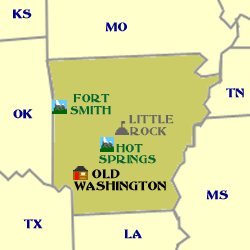Remains of first fort by Arkansas River
The land over the other side of the Arkansas River is now in Oklahoma, but it used to be Indian Territory. Only foundations remain of the first fort abandoned in 1824 but looking in this direction away from the town you can get a sense of how isolated its occupants must have felt.
Fort Smith National Historic Site
Fort Smith was first established on Christmas Day 1817 as a frontier fort to keep the peace between the Cherokee and Osage Indians. Like many frontier forts it had a short life of only 7 years before it was abandoned. Arkansas became a state in 1836 and the site of Fort Smith stood right on its western boundary so in 1838 Congress decided that a new fort should be built. Completed in 1846 it was used as a supply base for forts further west before being abandoned in 1871. With the land to the west then lawless Indian Territory from 1872 to 1896 the fort became a Federal Court and Jail.
DLU050901



Click on Minimap to navigate
Fort Smith Gallows
Judge Parker believed that there must be a better alternative to the death penalty. However Federal Law in those days required the death sentence if a jury returned a guilty verdict for murder or rape. The level of lawlessness in the area meant that Parker had to sentence 160 people to death during his time at Fort Smith, and during the first 14 years the condemned did not have a right of appeal. Parker was not known as ‘The Hanging Judge’ during his lifetime. During the 20th Century mythology painted Parker as a fanatic for the death sentence and along with the mythology came the name.
Reconstruction of Judge Parker's Courtroom
The most colourful phase of Fort Smith’s life stems from when the Indian Territories (now Oklahoma) just over the river became a base for all kinds of baddies. Although the court was set up at the fort in 1872 it was in 1875 its most famous character arrived. Isaac C. Parker was appointed judge for the Western District of Arkansas with the specific task of cleaning up the area. He remained in post for 21 years and is remembered as the ‘Hanging Judge’. Inside the fort this replica of his courtroom has been constructed and there is an exhibition showing what the jail was like.
Fort Smith Barracks, Courthouse & Jail
The two storey barracks of the second fort still stand, albeit much modified by their subsequent use as a federal courthouse and jail. For most of its life the second fort was a supply centre but it did see Civil War action. Arkansas was divided by the Civil War but it seceded from the Union in 1861 and joined the Confederacy. Union troops had abandoned the fort in anticipation of secession but they regained it from the Confederates in 1863. Despite attempts by the Confederates to re-take it, the fort remained in Union hands until the end of the war.



To move forwards or backwards through the Arkansas trail click the arrows above, or select your next destination on the Minimap.

© Mike Elsden 1981 - 2025
The contents of this page may not be reproduced in full or in part without permission
